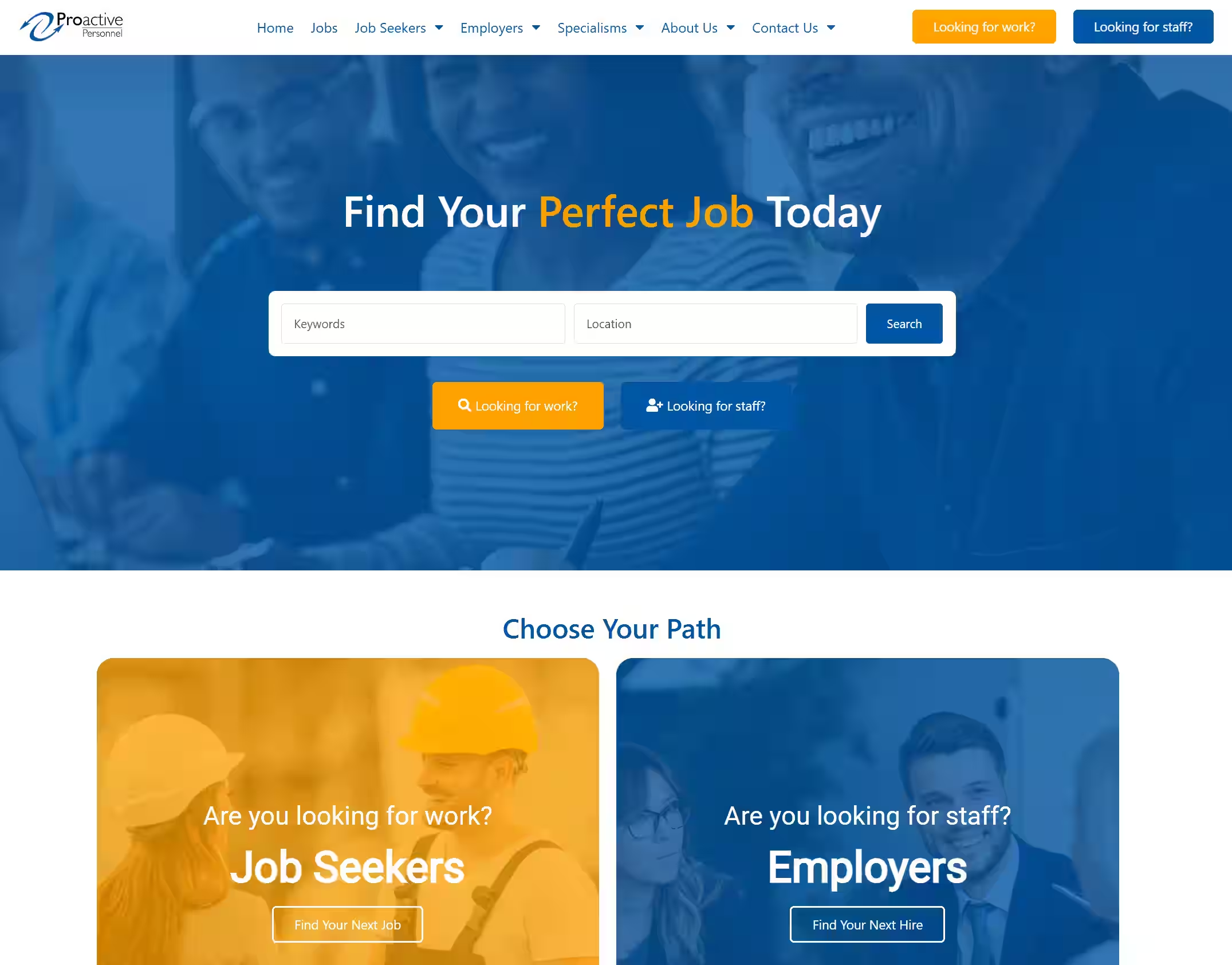How AMVIA Unified Recruitment Communications: The Proactive Personnel Story
Proactive Personnel reduced operational costs by 31% with AMVIA's CallSwitch One VoIP solution. See how multi-site recruitment agencies transform with unified communications.

Proactive Personnel, a 12-location UK recruitment agency, eliminated communications fragmentation and reduced operational costs by 31% by consolidating fragmented VoIP providers onto AMVIA's CallSwitch One platform. The 18-month phased implementation delivered 75% reduction in administrative overhead through advanced CRM integration, ensuring recruitment consultants stay connected to candidates and clients without missing opportunities.
The Recruitment Communications Crisis: When Downtime Costs Placements
Recruitment agencies live by the phone. Your consultants make 50–100 calls daily, and every missed connection represents a placement opportunity lost to a faster competitor. Yet Proactive Personnel was managing this mission-critical function with fragmented systems—multiple VoIP providers across 12 locations, inconsistent features, and contract renewal dates that created vendor management complexity rather than simplified operations.
When your team spends up to 70% of their working day on voice communications, inefficient systems don't just frustrate staff—they block revenue generation. A single location losing connectivity during peak placement hours can cost thousands in missed placements and damaged client relationships. And managing different vendors across different locations? That's 10+ hours per month of IT overhead that should be spent on strategy, not vendor firefighting.
AMVIA stepped in as telecommunications orchestrator, consolidating Proactive Personnel's fragmented infrastructure onto a unified CallSwitch One platform. This meant one provider, one contract, one renewal date—and most importantly, one direct line to expert support. This is the strategic alternative to managing vendor chaos.
Understanding the Business Context: Why Telecommunications Matters in Recruitment
Proactive Personnel operates a substantial recruitment network spanning Shropshire, the West Midlands, and North West England across 12 branch offices, placing thousands of candidates annually in industrial, technical, commercial, and transport sectors. The company's operational model depends entirely on rapid, reliable communication between consultants and both candidates and clients.
The recruitment industry's economics are unforgiving: telephony infrastructure isn't a support service—it's the primary revenue-generating channel. Unlike back-office functions where efficiency improvements contribute indirectly to profit, recruitment communication directly impacts placement speed and client satisfaction. When competitors are equally fast at matching talent to roles, the first to call often wins the placement.
Industry research confirms the stakes: 36% of companies still operate with up to 10 different communication and collaboration solutions, creating communication silos, contract complexity, and significant cost waste. For recruitment agencies specifically, this fragmentation means consultants waste time switching between platforms, duplicating work, and missing critical moments when candidates or clients call.
The Challenge: Fragmented Infrastructure, Fragmented Results
Multi-Site Complexity Without Enterprise Simplification
Before AMVIA's intervention, Proactive Personnel faced three interconnected problems:
Inconsistent Service Across Locations
Different VoIP providers meant different feature sets, different service levels, and different contract renewal dates. Consultants in one office had capabilities unavailable in another, making standardised workflows impossible. When you're trying to scale recruitment operations across 12 locations, this inconsistency slows decision-making and complicates training.
Administrative Burden Masquerading as Normal Operations
Managing multiple vendors requires multiple contract negotiations, multiple billing statements, multiple support relationships, and multiple escalation procedures. That's not operational overhead—that's business complexity that grows with each additional provider relationship.
Business Continuity Risk Without Visibility
A telephony outage in recruitment doesn't mean inconvenience; it means lost revenue. Yet with fragmented systems, there's no unified visibility into redundancy, failover capabilities, or SLA guarantees across all locations. If one provider goes down, you're managing the crisis with manual workarounds rather than engineered resilience.
AMVIA's Strategic Response: From Vendor Sprawl to Unified Operations
The Telecommunications Orchestration Approach
Rather than replacing Proactive Personnel's entire infrastructure overnight—a risky, disruptive approach—AMVIA positioned itself as the primary telecommunications orchestrator. This meant:
Leveraging Specialist Relationships
AMVIA brought established relationships with multiple network providers, enabling access to diverse infrastructure that would typically require Proactive Personnel to negotiate separately. This reduced complexity for the client while maintaining technical flexibility.
Implementing Enterprise-Grade Unified Communications
CallSwitch One, deployed across all 12 locations, provided a single platform for voice, call routing, CRM integration, and performance analytics. Google Cloud-based infrastructure eliminated single points of failure whilst delivering 99.9% uptime capability through geographic redundancy.
Aligning Contract Cycles
Rather than forcing immediate contract terminations (and associated early termination fees), AMVIA's phased 18-month rollout aligned implementation with existing contract expiration dates. This minimised costs whilst allowing knowledge transfer between phases and risk mitigation through sequential deployment rather than a risky big-bang approach.
Solution Architecture: Unified Communications Built for Recruitment Operations
CallSwitch One: Cloud-Native VoIP Infrastructure
The CallSwitch One platform operates on Google Cloud infrastructure, providing:
Enterprise-Grade Reliability Through Geographic Redundancy
Cloud-based architecture eliminates on-premises hardware vulnerabilities. Multiple data centres in different geographic locations ensure that local infrastructure failures don't disrupt operations. This is non-negotiable for recruitment agencies where even brief connectivity loss directly impacts revenue.
Advanced Call Routing and Routing Intelligence
Drag-and-drop IVR configuration enables time-based routing (directing calls to different locations based on office hours), skill-based routing (connecting candidates to specialists), and intelligent call queuing. For recruitment, this means candidate inquiries can be routed to available specialists rather than creating bottlenecks.
Open-API CRM Integration Architecture
This is the differentiator between enterprise platforms and traditional carrier solutions. Open APIs enable seamless integration with recruitment-specific CRM systems, enabling click-to-dial functionality, automatic call logging, and real-time candidate history display during conversations.
Yealink SIP-T46 Hardware: Enterprise Phones for High-Volume Operations
AMVIA specified enterprise-grade hardware for each consultant:
4.3-inch Colour Display with HD Voice Technology
The colour display enables intuitive call management and menu navigation—critical for recruitment professionals managing complex call scenarios. Yealink Optima HD Voice delivers crystal-clear audio through advanced acoustic clarity technology, echo cancellation, and adaptive jitter buffering.
Dual Gigabit Ethernet with Power-over-Ethernet (PoE)
This ensures reliable connectivity whilst simplifying physical infrastructure deployment across 12 locations. No dependency on fragmented power management—one cable delivers both power and connectivity.
USB Flexibility for Different Work Styles
Dual USB ports enable Bluetooth headsets, USB recording, and flexible connectivity for both office-based consultants and those working remotely for interviews.
Intelligent Wallboards: From Intuition to Analytics-Driven Management
Real-time performance dashboards transformed recruitment operations from intuition-based to analytics-driven:
Call Volume and Response Time Tracking
Managers can see live call volumes, average response times, and peak period identification—essential for right-sizing staffing and identifying training opportunities.
First-Call Resolution and Abandonment Metrics
Tracking the percentage of candidate inquiries resolved on first contact directly correlates with placement speed and client satisfaction.
Individual Consultant Performance Transparency
Calls per hour, placement conversion rates, and client satisfaction scores enable targeted coaching and performance recognition.
Implementation: The 18-Month Phased Rollout Strategy
Why Phased Deployment Reduced Risk and Costs
AMVIA's phased approach wasn't simply project management best practice—it was strategic cost optimisation:
Aligned with Existing Contract Expiration Dates
By sequencing implementation to match existing vendor contract end-dates, AMVIA avoided early termination penalties that often cost 20%+ of annual contract value. This phasing reduced total project costs by tens of thousands.
Sequential Risk Mitigation
Rather than implementing all 12 locations simultaneously, sequential deployment enabled technical issues to be identified and resolved before affecting the entire network. Early implementations provided learning that improved efficiency for subsequent phases.
Knowledge Transfer and Adoption
Early-phase consultants became experts who trained later-phase teams. This peer-led adoption proved far more effective than centralised training because consultants related to peers who'd already experienced the transition.
Change Management: From Resistance to Adoption
AMVIA's training programme addressed both technical functionality and workflow integration:
Feature-Specific Hands-On Training
Rather than abstract training about VoIP capabilities, AMVIA conducted training on practical features: call recording for quality assurance, wallboard interpretation for performance management, and CRM integration workflows for daily consultant activities.
Mobile App Adoption for Flexible Working
Recruitment consultants spend significant time outside the office (interviews, client meetings, site visits). Mobile VoIP apps enable consultants to maintain consultant numbers and access CRM integration from any location, supporting the flexibility recruitment teams require.
Leadership Alignment
AMVIA ensured recruitment operations managers understood how reporting and analytics directly supported their performance metrics and hiring targets. This wasn't just technology adoption—it was tool adoption that directly enabled business objectives.
Results: Quantified Business Outcomes Beyond Cost Reduction
31% Operational Cost Reduction
Vendor Consolidation Economics
Moving from multiple vendors to a single platform eliminated redundant provider management overhead, contract administration complexity, and pricing inefficiency. Standardised per-user pricing across all locations provided budget predictability and eliminated surprise charges.
Hardware Efficiency
Hosted VoIP architecture eliminated on-premises hardware maintenance costs and IT support requirements for traditional PBX systems. No more capital expenditure on equipment replacement; instead, predictable monthly costs that scale with headcount.
Integration Efficiencies
Native CRM integration eliminated manual workarounds and duplicate data entry. Consultants spend less time on administrative tasks and more time on revenue-generating activities.
75% Reduction in Administrative Overhead
Automated Call Logging and CRM Synchronisation
Rather than consultants manually logging calls after hanging up, CallSwitch One automatically records call data into the recruitment CRM. This alone saves 3–5 hours per consultant per week in administrative work.
Unified Vendor Management
One renewal date, one contract to negotiate, one support relationship, and one billing statement. This consolidation reduced IT management overhead by an estimated 10+ hours monthly—time redirected toward strategic initiatives.
Streamlined Contract Management
No more juggling multiple contract renewal dates, different SLAs, and inconsistent pricing models. One contract means one negotiation cycle annually.
30% Productivity Enhancement for Consultants
Integrated CRM Workflow: Click-to-Dial Functionality
Rather than manually dialling numbers from the CRM system, consultants click to dial, automatically launching call logging and candidate history display. For consultants handling 50–100 calls daily, this time-saving compounds significantly.
Real-Time Candidate and Client History
When an inbound call arrives, screen pop displays the full candidate or client record—previous placements, active requisitions, communication history. Consultants can provide contextually informed service without fumbling through records.
Mobile Work Flexibility
Mobile VoIP integration enables consultants to maintain candidate-facing phone numbers and CRM integration from anywhere, supporting remote interviews and client meetings without sacrificing communication capability.
Business Continuity Enhanced Through Engineering, Not Hope
Geographic Redundancy Architecture
CallSwitch One's multi-data-centre deployment ensures service continuity even if a single location experiences infrastructure failure. This moves business continuity from contingency planning to engineered architecture.
Network Path Diversity
Multiple internet service providers across locations ensure that connectivity failures in one location don't propagate to others. This architecture-level redundancy is fundamentally different from traditional telephony's single-point-of-failure vulnerability.
Automatic Failover and Call Routing
The platform automatically reroutes calls during infrastructure issues, ensuring candidates and clients experience transparent service continuity rather than voicemail and call-back delays.
Why Traditional Carriers Cannot Match This Outcomes
The research is clear: organisations consolidating to a single unified communications and collaboration provider achieve 54% increase in revenue versus 26% for companies using multiple providers. The competitive advantage isn't just cost—it's operational agility.
Traditional carriers like Vodafone or BT offer connectivity, but they lack:
Specialised CRM Integration Capabilities
Recruitment-specific integration is beyond traditional carrier scope. They offer generic APIs that require custom development. CallSwitch One's open-API architecture was built for recruitment operations from the ground up.
Recruitment Industry Expertise
AMVIA positioned itself as a telecommunications orchestrator with understanding of recruitment operations rather than a commodity connectivity provider. This domain expertise informed design decisions about features, reporting, and support requirements.
Pricing Transparency and Flexibility
Traditional carriers bundle services into complex packages with hidden fees and lock-in terms. CallSwitch One's per-user, per-month pricing model provides cost predictability and aligns expenses with headcount changes.
Strategic Learnings: Vendor Selection Criteria for Professional Services Organisations
API Integration Depth as Competitive Differentiator
Modern business technology is integration rather than standalone tools. Organizations moving to single unified communications providers experience 22% decrease in monthly cost per agent compared to multi-vendor environments. The cost advantage comes from seamless integration eliminating manual workarounds rather than simply consolidating billing.
When evaluating VoIP providers, assess:
Native CRM Integration Capabilities
Does the provider support your specific CRM platform? Are integrations pre-built or custom? Custom integrations create vendor lock-in and ongoing development costs.
Open API Standards
Can you integrate with tools beyond the provider's built-in capabilities? Open APIs enable future flexibility as your tech stack evolves.
Webhook and Real-Time Synchronisation
Does integration happen in real-time (automatic call logging) or batch process (manual data export)? Real-time integration eliminates administrative burden and ensures data accuracy.
Implementation Strategy: Phased Deployment Aligned With Business Cycles
The Proactive Personnel approach—aligning implementation with existing contract expirations rather than forcing immediate cutover—reflects best practice for multi-site deployments:
Minimises Financial Disruption
Early termination fees can consume 20%+ of annual contract value. Phased rollout aligned with existing renewal dates eliminates this cost.
Enables Knowledge Transfer
Early-phase consultants who've experienced the transition become experts who train later-phase teams. Peer-led adoption proves far more effective than centralised training.
Validates Architectural Decisions
Each phase provides learning about actual infrastructure performance, integration effectiveness, and user adoption. This learning informs subsequent phases, continuously improving implementation efficiency.
Business Continuity as Engineering, Not Contingency
For professional services organisations where communication infrastructure directly impacts revenue generation, business continuity cannot be an afterthought. The most cost-effective approach involves engineering redundancy into the architecture rather than planning for disaster recovery.
AMVIA's architecture delivered:
- Geographic data-centre redundancy ensuring local infrastructure failures don't disrupt all operations
- Network path diversity through multiple ISP connections preventing single points of failure
- Automatic failover and call routing providing transparent service continuity
This engineering-level reliability costs more upfront than basic connectivity but costs significantly less than revenue lost during infrastructure failures.
The Future: From Communications Tool to Competitive Advantage
VoIP technology continues to evolve rapidly. The global VoIP market is projected to reach $161.79 billion in 2025, with 35% growth in AI-driven features like real-time transcription, sentiment analysis, and intelligent call routing. Over 60% of organisations are expected to adopt AI-powered VoIP tools by 2025.
For recruitment agencies, these emerging capabilities create competitive advantages:
AI-Powered Call Analytics
Sentiment analysis during candidate conversations enables objective assessment beyond subjective interviewer impressions. Call transcription creates searchable records and training resources.
Intelligent Call Routing Optimisation
AI systems predict consultant availability and skill requirements, automatically optimising call routing to maximise first-call resolution and consultation time.
Predictive Business Continuity
Rather than simply detecting failures and routing around them, predictive analytics can identify infrastructure weakness before failure occurs.
AMVIA's approach to solution architecture emphasises future-proofing through open standards and flexible integration capabilities. This enables technology evolution without wholesale infrastructure replacement—the hallmark of truly strategic telecommunications partnerships.
Why AMVIA Matters: The Expert Alternative to Impersonal Giants
The Proactive Personnel transformation illustrates a fundamental market dynamic: recruitment agencies competing with identical speed and capability increasingly differentiate through operational efficiency. Your telephone system and unified communications platform directly impact consultant productivity, candidate experience, and ultimately, placement speed.
The difference between specialised telecommunications providers like AMVIA and commodity carriers comes down to three factors:
1. Domain Expertise
AMVIA understands recruitment operations, not just connectivity. This expertise informed design decisions about features, reporting, and integration capabilities specifically valuable for recruitment workflows.
2. Partnership Economics
AMVIA positioned itself as an orchestrator managing multiple technology relationships on behalf of clients, rather than forcing clients into proprietary lock-in. This partnership approach enables better outcomes than traditional vendor relationships.
3. Technical Excellence Without Compromise
Enterprise-grade reliability—99.9% uptime, geographic redundancy, automatic failover—is non-negotiable for revenue-generating infrastructure. AMVIA's architecture delivers this technical excellence alongside business-focused implementation strategy.
Taking Action: Your Transformation Starts With Diagnosis
If your recruitment agency is managing multiple VoIP vendors across multiple locations, you're leaving money on the table and productivity on the floor. Your consultants are spending 10+ hours monthly managing vendor relationships instead of focusing on placements. Your operational costs are higher than necessary. Your consultants are missing opportunities because systems aren't integrated.
Get your free telecommunications audit today.
Call AMVIA directly at 0333 733 8050—you'll speak to a UK-based expert within 90 seconds, no voicemail, no call queues. AMVIA will assess your current infrastructure, identify inefficiencies, and show you exactly how consolidation could improve your operations.
The Proactive Personnel case study isn't exceptional—it's the expected outcome when professional services organisations align their communications infrastructure with their business strategy. 31% cost reduction, 75% administrative overhead elimination, and 30% productivity enhancement aren't aspirational targets; they're the quantified results of moving from fragmented complexity to unified excellence.
Your competitors are already moving. The question is whether your recruitment team will lead or follow.
Schedule your 30-minute consultation today - Call 0333 733 8050.
Transform Your Business Communications with AMVIA
Stay Ahead: Leading Cybersecurity Threat Intelligence, Direct to Your Inbox
Monthly expert-curated updates empower you to protect your business with actionable cybersecurity insights, the latest threat data, and proven defences—trusted by UK IT leaders for reliability and clarity.



